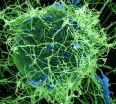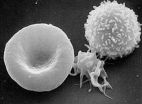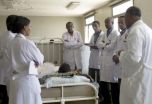(Press-News.org) New York, NY—August 14, 2014—A new technique developed by Elisa Konofagou, associate professor of biomedical engineering and radiology at Columbia Engineering, has demonstrated for the first time that the size of molecules penetrating the blood-brain barrier (BBB) can be controlled using acoustic pressure—the pressure of an ultrasound beam—to let specific molecules through. The study was published in the July issue of the Journal of Cerebral Blood Flow & Metabolism.
"This is an important breakthrough in getting drugs delivered to specific parts of the brain precisely, non-invasively, and safely, and may help in the treatment of central nervous system diseases like Parkinson's and Alzheimer's," says Konofagou, whose National Institutes of Health Research Project Grant (R01) funding was just renewed for another four years for an additional $2.22 million. The award is for research to determine the role of the microbubble in controlling both the efficacy and safety of drug safety through the BBB with a specific application for treating Parkinson's disease.
Most small—and all large—molecule drugs do not currently penetrate the blood-brain barrier that sits between the vascular bed and the brain tissue. "As a result," Konofagou explains, "all central nervous system diseases remain undertreated at best. For example, we know that Parkinson's disease would benefit by delivery of therapeutic molecules to the neurons so as to impede their slow death. But because of the virtually impermeable barrier, these drugs can only reach the brain through direct injection and that requires anesthesia and drilling the skull while also increasing the risk of infection and limiting the number of sites of injection. And transcranial injections rarely work—only about one in ten is successful."
Focused ultrasound in conjunction with microbubbles—gas-filled bubbles coated by protein or lipid shells—continues to be the only technique that can permeate the BBB safely and non-invasively. When microbubbles are hit by an ultrasound beam, they start oscillating and, depending on the magnitude of the pressure, continue oscillating or collapse. While researchers have found that focused ultrasound in combination with microbubble cavitation can be successfully used in the delivery of therapeutic drugs across the BBB, almost all earlier studies have been limited to one specific-sized agent that is commercially available and widely used clinically as ultrasound contrast agents. Konofagou and her team were convinced there was a way to induce a size-controllable BBB opening, enabling a more effective method to improve localized brain drug delivery.
Konofagou targeted the hippocampus, the memory center of the brain, and administered different-sized sugar molecules (Dextran). She found that higher acoustic pressures led to larger molecules accumulating into the hippocampus as confirmed by fluorescence imaging. This demonstrated that the pressure of the ultrasound beam can be adjusted depending on the size of the drug that needs to be delivered to the brain: all molecules of variant sizes were able to penetrate the opened barrier but at distinct pressures, i.e., small molecules at lower pressures and larger molecules at higher pressures.
"Through this study, we've been able to show, for the first time, that we can control the BBB opening size through the use of acoustic pressure," says Konofagou. "We've also learned much more about the physical mechanisms associated with the trans-BBB delivery of different-sized agents, and understanding the BBB mechanisms will help us to develop agent size-specific focused ultrasound treatment protocols."
Konofagou and her Ultrasound Elasticity Imaging Laboratory team plan to continue to work on the treatment of Alzheimer's and Parkinson's in a range of models, and hope to test their technique in clinical trials within the next five years.
"It is frightening to think that in the 21st century we still have no idea now to treat most brain diseases," Konofagou adds. "But we're really excited because we now have a tool that could potentially change the current dire predictions that come with a neurological disorder diagnosis."
INFORMATION: END
New non-invasive technique controls size of molecules penetrating the blood-brain barrier
Innovative ultrasound approach uses acoustic pressure to let molecules through -- may help treatment for central nervous system diseases like Parkinson's and Alzheimer's
2014-08-14
ELSE PRESS RELEASES FROM THIS DATE:
Workaholism: The addiction of this century
2014-08-14
In spite of the many positive aspects of work, some people are unable to detach from it – working excessively and compulsively. These are called workaholics.
Postdoctoral Fellow Cecilie Schou Andreassen and colleagues from the Department of Psychosocial Science at the University of Bergen (UiB) in Norway has been the first to assess workaholism in a nationally representative sample.
According to Schou Andreassen, the "workaholism" concept has been studied by scholars for nearly 45 years. Still, reliable statistics on the prevalence of workaholism is hard to find. The ...
EARTH Magazine: La Brea climate adaptation as different as cats and dogs
2014-08-14
Alexandria, Va. — The La Brea tar pits in downtown Los Angeles are a famous predator trap. For every herbivore, a dozen or more carnivores — saber-toothed cats and dire wolves chief among them — are pulled from the prolific Pleistocene fossil site. In fact, the remains of more than 4,000 dire wolves have been excavated, along with more than 2,000 saber-toothed cats. The sheer number of fossils allows researchers to ask population-level questions about the climate and environment as well as how these animals evolved.
Now, two new studies focusing dire wolves and saber-toothed ...
Ebola outbreak highlights global disparities in health-care resources
2014-08-14
The outbreak of Ebola virus disease that has claimed more than 1,000 lives in West Africa this year poses a serious, ongoing threat to that region: the spread to capital cities and Nigeria—Africa's most populous nation—presents new challenges for healthcare professionals. The situation has garnered significant attention and fear around the world, but proven public health measures and sharpened clinical vigilance will contain the epidemic and thwart a global spread, according to a new commentary by Anthony S. Fauci, M.D., director of the National Institute of Allergy and ...
New blood: Tracing the beginnings of hematopoietic stem cells
2014-08-14
Hematopoietic stem cells (HSCs) give rise to all other blood cell types, but their development and how their fate is determined has long remained a mystery. In a paper published online this week in Nature, researchers at the University of California, San Diego School of Medicine elaborate upon a crucial signaling pathway and the role of key proteins, which may help clear the way to generate HSCs from human pluripotent precursors, similar to advances with other kinds of tissue stem cells.
Principal investigator David Traver, PhD, professor in the Department of Cellular ...
Novel chip-based platform could simplify measurements of single molecules
2014-08-14
Researchers at UC Santa Cruz have developed a new approach for studying single molecules and nanoparticles by combining electrical and optical measurements on an integrated chip-based platform. In a paper published July 9 in Nano Letters, the researchers reported using the device to distinguish viruses from similarly-sized nanoparticles with 100 percent fidelity.
Combining electrical and optical measurements on a single chip provides more information than either technique alone, said corresponding author Holger Schmidt, the Kapany Professor of Optoelectronics in the Baskin ...
Stem cells in the skeletal muscle promote the regeneration of severe nerve peripheral injury
2014-08-14
A research group at the muscle physiology and cell biology unit, the Tokai University School of Medicine, Japan, led by Dr. Tetsuro Tamaki, have developed the stem cell isolation method from the skeletal muscle, termed skeletal muscle-derived multipotent stem cells (Sk-MSCs), which can differentiate into Schwann and perineurial/endoneurial cells, and vascular relating pericytes, endothelial and smooth muscle cells in the damaged peripheral nerve niche. Application of the Sk-MSCs in the bridging conduit of the long nerve gap injury resulted favorable axonal regeneration ...
Up-regulation of neuronal alpha-1 adrenoceptors after peripheral nerve injury
2014-08-14
In a Perspectives paper published in Neural Regeneration Research (Vol. 9, No. 14), Professor Peter Drummond speculates about neuronal changes that might contribute to chronic pain after peripheral nerve injury. Professor Drummond and co-workers at Murdoch University, Perth Western Australia, discovered recently that the expression of α1-adrenoceptors increases on pain-signalling nerve fibers that survive peripheral injury. As these receptors boost neural excitability, an increase in their expression could intensify pain. After tissue injury, resident cells and other ...
New frontiers of fecal microbiota transplantation
2014-08-14
Bethesda, MD (Aug. 14, 2014) – Fecal microbiota transplantation (FMT) is one of the most innovative new treatments of the 21st century. Experts believe that this procedure, which transplants microbes from one human gut to another through fecal matter, could offer the cure to a vast range of diseases and shed new light on the role of the microbiome in gastrointestinal diseases. New research presented this weekend at the American Gastroenterological Association's 2014 James W. Freston Conference in Chicago, IL, highlights significant advances in this field, and confirms the ...
Scientists detail urgent research agenda to address chronic disease toll
2014-08-14
Health care systems that keep HIV patients from dying early in low- and middle-income nations need urgently to be repurposed to treat the chronic diseases that many of these patients now have, experts say.
According to recommendations resulting from a multidisciplinary conference sponsored by the National Institutes of Health, scientists and physicians in low- and middle-income countries should build on existing HIV research to study and treat chronic conditions. Patients once condemned to death by AIDS now suffer from noncommunicable diseases such as tuberculosis, cancer, ...
Study of Chilean quake shows potential for future earthquake
2014-08-14
Near real-time analysis of the April 1 earthquake in Iquique, Chile, showed that the 8.2 event occurred in a gap on the fault unruptured since 1877 and that the April event was not what the scientists had expected, according to an international team of geologists.
"We assumed that the area of the 1877 earthquake would eventually rupture, but all indications are that this 8.2 event was not the 8.8 event we were looking for," said Kevin P. Furlong, professor of geophysics, Penn State. "We looked at it to see if this was the big one."
But according to the researchers, ...
LAST 30 PRESS RELEASES:
Making lighter work of calculating fluid and heat flow
Normalizing blood sugar can halve heart attack risk
Lowering blood sugar cuts heart attack risk in people with prediabetes
Study links genetic variants to risk of blinding eye disease in premature infants
Non-opioid ‘pain sponge’ therapy halts cartilage degeneration and relieves chronic pain
AI can pick up cultural values by mimicking how kids learn
China’s ecological redlines offer fast track to 30 x 30 global conservation goal
Invisible indoor threats: emerging household contaminants and their growing risks to human health
Adding antibody treatment to chemo boosts outcomes for children with rare cancer
Germline pathogenic variants among women without a history of breast cancer
Tanning beds triple melanoma risk, potentially causing broad DNA damage
Unique bond identified as key to viral infection speed
Indoor tanning makes youthful skin much older on a genetic level
Mouse model sheds new light on the causes and potential solutions to human GI problems linked to muscular dystrophy
The Journal of Nuclear Medicine ahead-of-print tip sheet: December 12, 2025
Smarter tools for peering into the microscopic world
Applications open for funding to conduct research in the Kinsey Institute archives
Global measure underestimates the severity of food insecurity
Child survivors of critical illness are missing out on timely follow up care
Risk-based vs annual breast cancer screening / the WISDOM randomized clinical trial
University of Toronto launches Electric Vehicle Innovation Ontario to accelerate advanced EV technologies and build Canada’s innovation advantage
Early relapse predicts poor outcomes in aggressive blood cancer
American College of Lifestyle Medicine applauds two CMS models aligned with lifestyle medicine practice and reimbursement
Clinical trial finds cannabis use not a barrier to quitting nicotine vaping
Supplemental nutrition assistance program policies and food insecurity
Switching immune cells to “night mode” could limit damage after a heart attack, study suggests
URI-based Global RIghts Project report spotlights continued troubling trends in worldwide inhumane treatment
Neutrophils are less aggressive at night, explaining why nighttime heart attacks cause less damage than daytime events
Menopausal hormone therapy may not pose breast cancer risk for women with BRCA mutations
Mobile health tool may improve quality of life for adolescent and young adult breast cancer survivors
[Press-News.org] New non-invasive technique controls size of molecules penetrating the blood-brain barrierInnovative ultrasound approach uses acoustic pressure to let molecules through -- may help treatment for central nervous system diseases like Parkinson's and Alzheimer's




